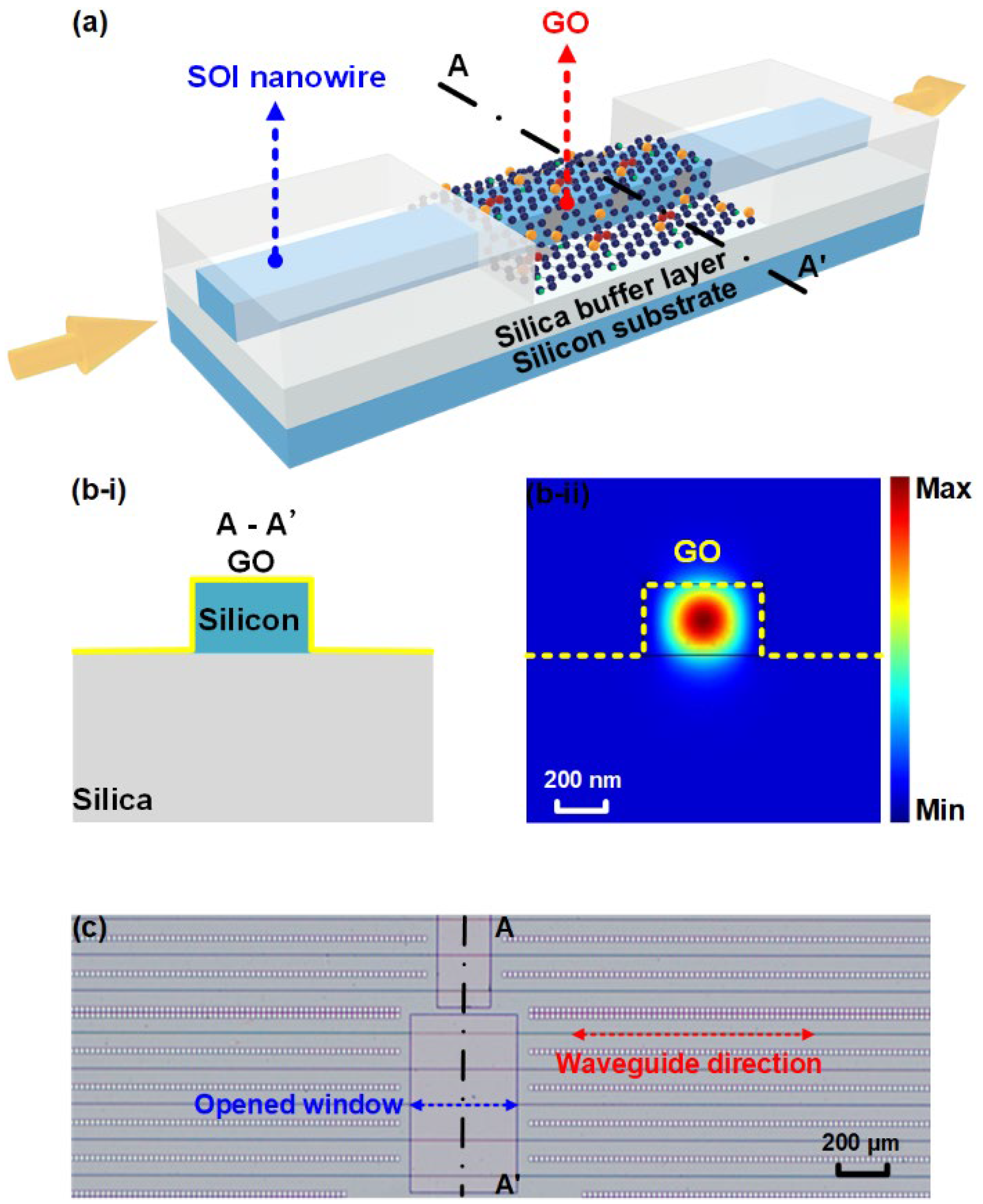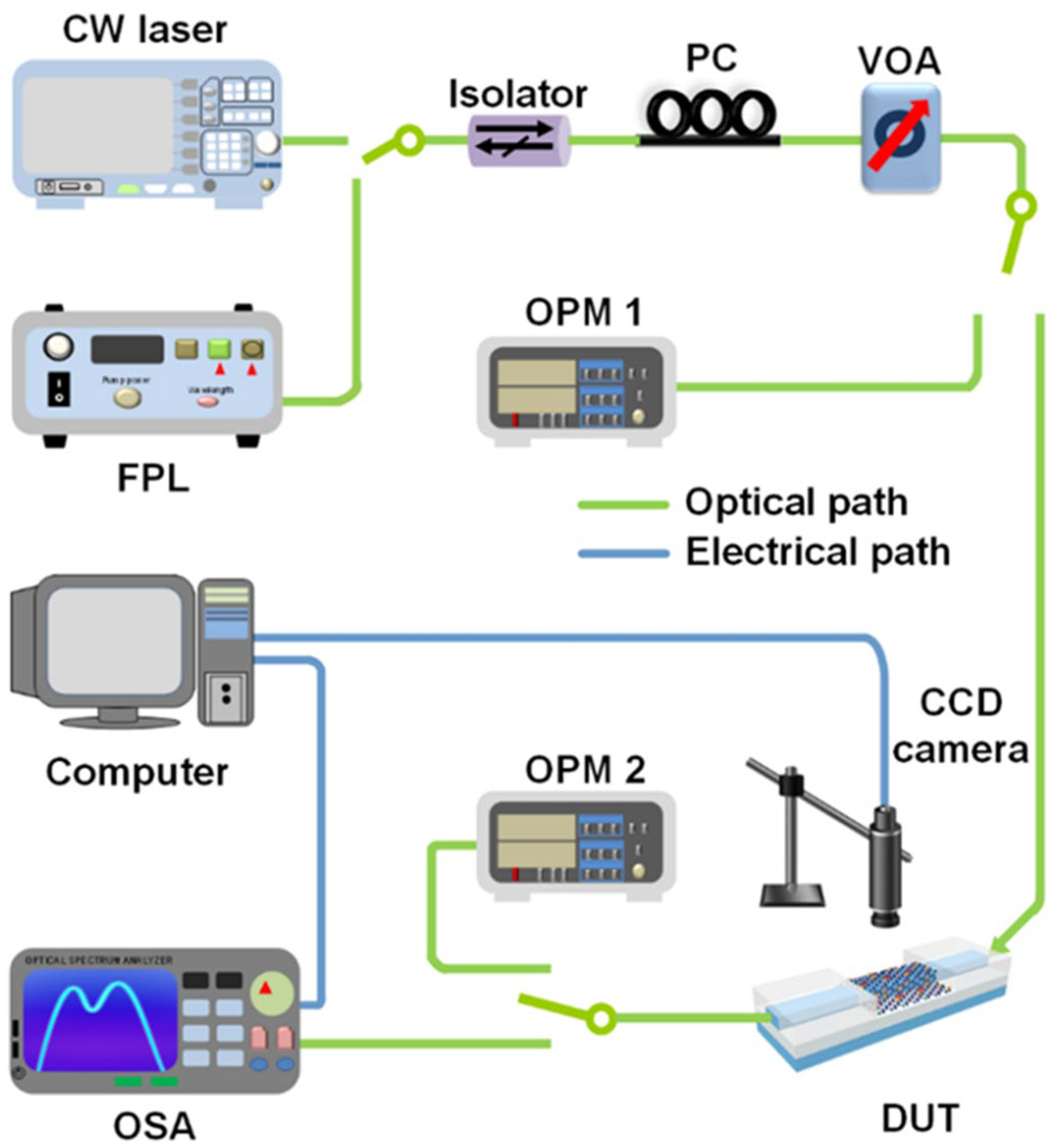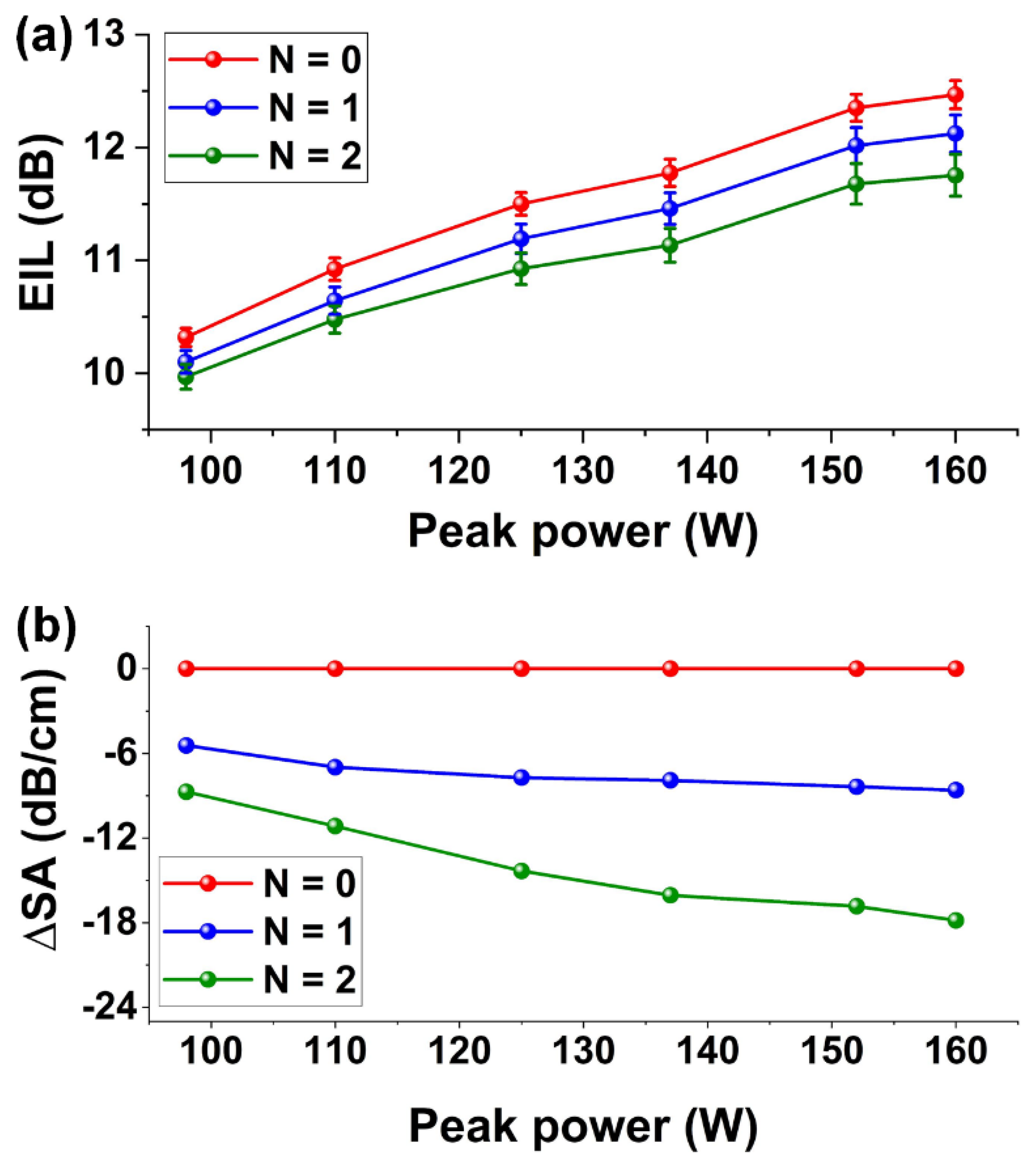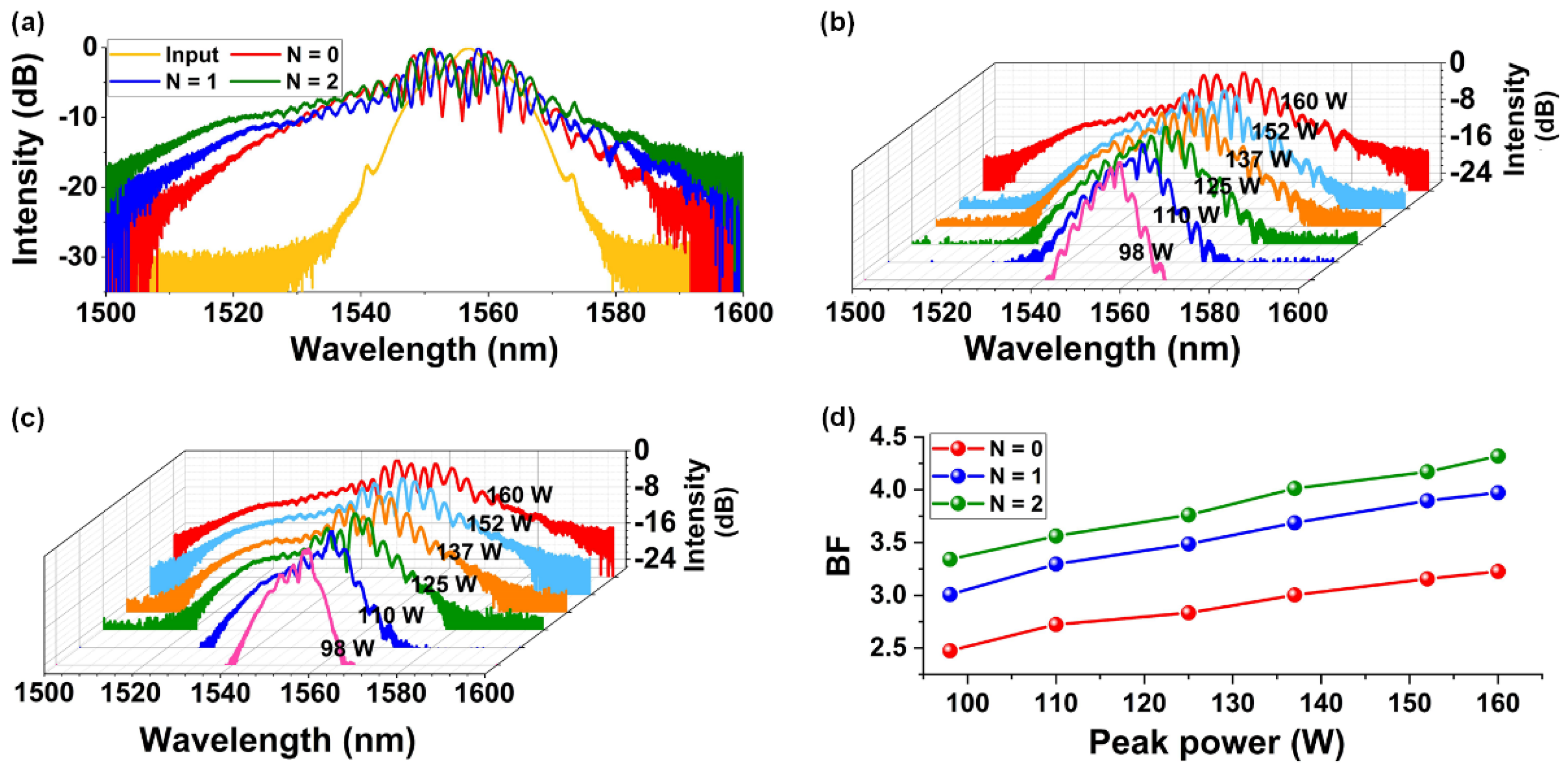Enhanced Spectral Broadening of Femtosecond Optical Pulses in Silicon Nanowires Integrated with 2D Graphene Oxide Films
Abstract
:1. Introduction
2. Device and Characterization
3. Loss Measurements
4. SPM Measurements
5. Theoretically Analysis and Discussion
6. Conclusions
Author Contributions
Funding
Institutional Review Board Statement
Informed Consent Statement
Data Availability Statement
Acknowledgments
Conflicts of Interest
References
- Stolen, R.H.; Lin, C. Self-phase-modulation in silica optical fibers. Phys. Rev. A 1978, 17, 1448. [Google Scholar] [CrossRef]
- Agrawal, G.P.; Olsson, N.A. Self-phase modulation and spectral broadening of optical pulses in semiconductor laser amplifiers. IEEE J. Quantum Electron. 1989, 25, 2297–2306. [Google Scholar] [CrossRef]
- Wu, L.; Yuan, X.M.; Zhang, D.Y.; Huang, W.; Ge, Y.; Song, Y.; Xiang, Y.; Li, J.; Zhang, H. Recent advances of spatial self-phase modulation in 2D materials and passive photonic device applications. Small 2020, 16, 2002252. [Google Scholar] [CrossRef] [PubMed]
- Guo, H.; Herkommer, C.; Billat, A.; Grassani, D.; Zhang, C.; Pfeiffer, M.H.P.; Weng, W.; Brès, C.S.; Kippenberg, T.J. Mid-infrared frequency comb via coherent dispersive wave generation in silicon nitride nanophotonic waveguides. Nat. Photonics 2018, 12, 330–335. [Google Scholar] [CrossRef]
- Yu, Y.; Gai, X.; Ma, P.; Choi, D.Y.; Yang, Z.; Wang, R.; Debbarma, S.; Madden, S.J.; Davies, B.L. A broadband, quasi-continuous, mid-infrared supercontinuum generated in a chalcogenide glass waveguide. Laser Photonics Rev. 2014, 8, 792–798. [Google Scholar] [CrossRef]
- Hult, J.; Watt, R.S.; Kaminski, C.F. High bandwidth absorption spectroscopy with a dispersed supercontinuum source. Opt. Express 2007, 15, 11385–11395. [Google Scholar] [CrossRef] [Green Version]
- Kaltenecker, K.J.; Rao, D.S.S.; Rasmussen, M.; Lassen, H.B.; Kelleher, E.J.; Krauss, E.; Hecht, B.; Mortensen, N.A.; Nielsen, L.G.; Markos, C. Near-infrared nanospectroscopy using a low-noise supercontinuum source. APL Photonics 2021, 6, 066106. [Google Scholar] [CrossRef]
- Wu, L.; Zhang, Y.; Yuan, X.; Zhang, F.; Huang, W.; Ma, D.; Zhao, J.; Wang, Y.; Ge, Y.; Huang, H. 1D@ 0D hybrid dimensional heterojunction-based photonics logical gate and isolator. Appl. Mater. Today 2020, 19, 100589. [Google Scholar] [CrossRef]
- Singh, P.; Tripathi, D.K.; Jaiswal, S.; Dixit, H. All-optical logic gates: Designs, classification, and comparison. Adv. Opt. Technol. 2014, 2014, 275083. [Google Scholar] [CrossRef]
- Krebs, N.; Pugliesi, I.; Riedle, E. Pulse compression of ultrashort UV pulses by self-phase modulation in bulk material. Appl. Sci. 2013, 3, 153–167. [Google Scholar] [CrossRef] [Green Version]
- Peccianti, M.; Ferrera, M.; Razzari, L.; Morandotti, R.; Little, B.E.; Chu, S.T.; Moss, D.J. Subpicosecond optical pulse compression via an integrated nonlinear chirper. Opt. Express 2010, 18, 7625–7633. [Google Scholar] [CrossRef] [PubMed]
- Dong, Y.; Chertopalov, S.; Maleski, K.; Anasori, B.; Hu, L.; Bhattacharya, S.; Rao, A.M.; Gogotsi, Y.; Mochalin, V.N.; Podila, R. Saturable absorption in 2D Ti3C2 MXene thin films for passive photonic diodes. Adv. Mater. 2018, 30, 1705714. [Google Scholar] [CrossRef] [PubMed]
- Konorov, S.; Biryukov, D.S.; Bugar, I.; Bloemer, M.; Beloglazov, V.; Skibina, N.B.; Chorvat, D., Jr.; Chorvat, D.; Scalora, M.; Zheltikov, A. Experimental demonstration of a photonic-crystal-fiber optical diode. Appl. Phys. B 2004, 78, 547–550. [Google Scholar] [CrossRef]
- Wu, L.; Huang, W.; Wang, Y.; Zhao, J.; Ma, D.; Xiang, Y.; Li, J.; Ponraj, J.S.; Dhanabalan, S.C.; Zhang, H. 2D tellurium based high-performance all-optical nonlinear photonic devices. Adv. Funct. Mater. 2019, 29, 1806346. [Google Scholar] [CrossRef]
- Wu, L.; Jiang, X.; Zhao, J.; Liang, W.; Li, Z.; Huang, W.; Lin, Z.; Wang, Y.; Zhang, F.; Lu, S. 2D MXene: MXene-based nonlinear optical information converter for all-optical modulator and switcher. Laser Photonics Rev. 2018, 12, 1870055. [Google Scholar] [CrossRef] [Green Version]
- Moon, S.; Kim, D.Y. Ultra-high-speed optical coherence tomography with a stretched pulse supercontinuum source. Opt. Express 2006, 14, 11575–11584. [Google Scholar] [CrossRef]
- Sumimura, K.; Genda, Y.; Ohta, T.; Itoh, K.; Nishizawa, N. Quasi-supercontinuum generation using 1.06 μmultrashort-pulse laser system for ultrahigh-resolution optical-coherence tomography. Opt. Lett. 2010, 35, 3631–3633. [Google Scholar] [CrossRef]
- Dulkeith, E.; Vlasov, Y.A.; Chen, X.; Panoiu, N.C.; Osgood, R.M. Self-phase-modulation in submicron silicon-on-insulator photonic wires. Opt. Express 2006, 14, 5524–5534. [Google Scholar] [CrossRef]
- Boyraz, O.; Indukuri, T.; Jalali, B. Self-phase-modulation induced spectral broadening in silicon waveguides. Opt. Express 2004, 12, 829–834. [Google Scholar] [CrossRef]
- Tan, D.; Ikeda, K.; Sun, P.; Fainman, Y. Group velocity dispersion and self phase modulation in silicon nitride waveguides. Appl. Phys. Lett. 2010, 96, 061101. [Google Scholar] [CrossRef] [Green Version]
- Duchesne, D.; Ferrera, M.; Razzari, L.; Morandotti, R.; Little, B.E.; Chu, S.T.; Moss, D.J. Efficient self-phase modulation in low loss, high index doped silica glass integrated waveguides. Opt. Express 2009, 17, 1865–1870. [Google Scholar] [CrossRef] [PubMed]
- Bogaerts, W.; Chrostowski, L. Silicon photonics circuit design: Methods, tools and challenges. Laser Photonics Rev. 2018, 12, 1700237. [Google Scholar] [CrossRef]
- Feng, S.; Lei, T.; Chen, H.; Cai, H.; Luo, X.; Poon, A.W. Silicon photonics: From a microresonator perspective. Laser Photonics Rev. 2012, 6, 145–177. [Google Scholar] [CrossRef]
- Reed, G.T.; Mashanovich, G.; Gardes, F.Y.; Thomson, D. Silicon optical modulators. Nat. Photonics 2010, 4, 518–526. [Google Scholar] [CrossRef] [Green Version]
- Leuthold, J.; Koos, C.; Freude, W. Nonlinear silicon photonics. Nat. Photonics 2010, 4, 535–544. [Google Scholar] [CrossRef]
- Gajda, A.; Zimmermann, L.; Jazayerifar, M.; Winzer, G.; Tian, H.; Elschner, R.; Richter, T.; Schubert, C.; Tillack, B.; Petermann, K.J.O.E. Highly efficient CW parametric conversion at 1550 nm in SOI waveguides by reverse biased pin junction. Opt. Express 2012, 20, 13100–13107. [Google Scholar] [CrossRef]
- Da Ros, F.; Vukovic, D.; Gajda, A.; Dalgaard, K.; Zimmermann, L.; Tillack, B.; Galili, M.; Petermann, K.; Peucheret, C.J.O.E. Phase regeneration of DPSK signals in a silicon waveguide with reverse-biased pin junction. Opt. Express 2014, 22, 5029–5036. [Google Scholar] [CrossRef]
- Sackey, I.; Gajda, A.; Peczek, A.; Liebig, E.; Zimmermann, L.; Petermann, K.; Schubert, C.J.O.E. 1.024 Tb/s wavelength conversion in a silicon waveguide with reverse-biased pin junction. Opt. Express 2017, 25, 21229–21240. [Google Scholar] [CrossRef]
- Kuo, Y.H.; Rong, H.; Sih, V.; Xu, S.; Paniccia, M.; Cohen, O.J.O.E. Demonstration of wavelength conversion at 40 Gb/s data rate in silicon waveguides. Opt. Express 2006, 14, 11721–11726. [Google Scholar] [CrossRef] [Green Version]
- Moss, D.J.; Morandotti, R.; Gaeta, A.L.; Lipson, M. New CMOS-compatible platforms based on silicon nitride and Hydex for nonlinear optics. Nat. Photonics 2013, 7, 597–607. [Google Scholar] [CrossRef] [Green Version]
- Foster, M.A.; Turner, A.C.; Sharping, J.E.; Schmidt, B.S.; Lipson, M.; Gaeta, A.L. Broad-band optical parametric gain on a silicon photonic chip. Nature 2006, 441, 960–963. [Google Scholar] [CrossRef] [PubMed]
- Qu, Y.; Wu, J.; Zhang, Y.; Jia, L.; Liang, Y.; Jia, B.; Moss, D.J. Analysis of four-wave mixing in silicon nitride waveguides integrated with 2D layered graphene oxide films. J. Lightwave Technol. 2021, 39, 2902–2910. [Google Scholar] [CrossRef]
- Zhang, Y.; Wu, J.; Qu, Y.; Jia, L.; Jia, B.; Moss, D.J. Optimizing the Kerr nonlinear optical performance of silicon waveguides integrated with 2D graphene oxide films. J. Lightwave Technol. 2021, 39, 4671–4683. [Google Scholar] [CrossRef]
- Ishizawa, A.; Kou, R.; Goto, T.; Tsuchizawa, T.; Matsuda, N.; Hitachi, K.; Nishikawa, T.; Yamada, K.; Sogawa, T.; Gotoh, H. Optical nonlinearity enhancement with graphene-decorated silicon waveguides. Sci. Rep. 2017, 7, 45520. [Google Scholar] [CrossRef] [PubMed]
- Vermeulen, N.; Lurbe, D.C.; Khoder, M.; Pasternak, I.; Krajewska, A.; Ciuk, T.; Strupinski, W.; Cheng, J.; Thienpont, H.; Van Erps, J. Graphene’s nonlinear-optical physics revealed through exponentially growing self-phase modulation. Nat. Commun. 2018, 9, 2675. [Google Scholar] [CrossRef] [PubMed]
- Feng, Q.; Cong, H.; Zhang, B.; Wei, W.; Liang, Y.; Fang, S.; Wang, T.; Zhang, J. Enhanced optical Kerr nonlinearity of graphene/Si hybrid waveguide. Appl. Phys. Lett. 2019, 114, 071104. [Google Scholar] [CrossRef] [Green Version]
- Liu, L.; Xu, K.; Wan, X.; Xu, J.; Wong, C.Y.; Tsang, H.K. Enhanced optical Kerr nonlinearity of MoS2 on silicon waveguides. Photon. Res. 2015, 3, 206–209. [Google Scholar] [CrossRef]
- Wang, Y.; Pelgrin, V.; Gyger, S.; Uddin, G.M.; Bai, X.; Lafforgue, C.; Vivien, L.; Jöns, K.D.; Cassan, E.; Sun, Z. Enhancing Si3N4 waveguide nonlinearity with heterogeneous integration of few-layer WS2. ACS Photonics 2021, 8, 2713–2721. [Google Scholar] [CrossRef]
- Zhang, Y.; Wu, J.; Yang, Y.; Qu, Y.; Jia, L.; Moein, T.; Jia, B.; Moss, D.J. Enhanced Kerr nonlinearity and nonlinear figure of merit in silicon nanowires integrated with 2D graphene oxide films. ACS Appl. Mater. Interfaces 2020, 12, 33094–33103. [Google Scholar] [CrossRef]
- Zheng, X.; Jia, B.; Chen, X.; Gu, M. In situ third-order non-linear responses during laser reduction of graphene oxide thin films towards on-chip non-linear photonic devices. Adv. Mater. 2014, 26, 2699–2703. [Google Scholar] [CrossRef]
- Wu, J.; Jia, L.; Zhang, Y.; Qu, Y.; Jia, B.; Moss, D.J. Graphene oxide for integrated photonics and flat optics. Adv. Mater. 2020, 33, 2006415. [Google Scholar] [CrossRef] [PubMed]
- Wu, J.; Yang, Y.; Qu, Y.; Jia, L.; Zhang, Y.; Xu, X.; Chu, S.T.; Little, B.E.; Morandotti, R.; Jia, B.; et al. 2D layered graphene oxide films integrated with micro-ring resonators for enhanced nonlinear optics. Small 2020, 16, 1906563. [Google Scholar] [CrossRef] [PubMed] [Green Version]
- Zhang, Y.; Wu, J.; Qu, Y.; Jia, L.; Jia, B.; Moss, D.J. Design and optimization of four-wave mixing in microring resonators integrated with 2D graphene oxide films. J. Lightwave Technol. 2021, 39, 6553–6562. [Google Scholar] [CrossRef]
- Qu, Y.; Wu, J.; Yang, Y.; Zhang, Y.; Liang, Y.; El Dirani, H.; Crochemore, R.; Demongodin, P.; Sciancalepore, C.; Grillet, C.; et al. Enhanced four-wave mixing in silicon nitride waveguides integrated with 2D layered graphene oxide films. Adv. Opt. Mater. 2020, 8, 2001048. [Google Scholar] [CrossRef]
- Wu, J.; Yang, Y.; Qu, Y.; Xu, X.; Liang, Y.; Chu, S.T.; Little, B.E.; Morandotti, R.; Jia, B.; Moss, D.J. Graphene oxide waveguide and micro-ring resonator polarizers. Laser Photonics Rev. 2019, 13, 1900056. [Google Scholar] [CrossRef] [Green Version]
- Yang, Y.; Wu, J.; Xu, X.; Liang, Y.; Chu, S.T.; Little, B.E.; Morandotti, R.; Jia, B.; Moss, D.J. Invited article: Enhanced four-wave mixing in waveguides integrated with graphene oxide. APL Photonics 2018, 3, 120803. [Google Scholar] [CrossRef] [Green Version]
- Yang, Y.; Lin, H.; Zhang, B.Y.; Zhang, Y.; Zheng, X.; Yu, A.; Hong, M.; Jia, B. Graphene-based multilayered metamaterials with phototunable architecture for on-chip photonic devices. ACS Photonics 2019, 6, 1033–1040. [Google Scholar] [CrossRef]
- Jia, L.; Wu, J.; Zhang, Y.; Qu, Y.; Jia, B.; Chen, Z.; Moss, D.J. Fabrication technologies for the on-chip integration of 2D materials. Small Methods 2022, 6, 2101435. [Google Scholar] [CrossRef]
- Yang, Y.; Liu, R.; Wu, J.; Jiang, X.; Cao, P.; Hu, X.; Pan, T.; Qiu, C.; Yang, J.; Song, Y. Bottom-up fabrication of graphene on silicon/silica substrate via a facile soft-hard template approach. Sci. Rep. 2015, 5, 13480. [Google Scholar] [CrossRef] [Green Version]
- Hong, J.; Lee, K.; Son, B.; Park, S.; Park, D.; Park, J.Y.; Lee, S.; Ahn, Y.J.O.E. Terahertz conductivity of reduced graphene oxide films. Opt. Express 2013, 21, 7633–7640. [Google Scholar] [CrossRef]
- Furio, A.; Landi, G.; Altavilla, C.; Sofia, D.; Iannace, S.; Sorrentino, A.; Neitzert, H.J.N. Light irradiation tuning of surface wettability, optical, and electric properties of graphene oxide thin films. Nanotechnology 2016, 28, 054003. [Google Scholar] [CrossRef] [PubMed]
- Gu, T.; Petrone, N.; McMillan, J.F.; Van der Zande, A.; Yu, M.; Lo, G.Q.; Kwong, D.L.; Hone, J.; Wong, C.W. Regenerative oscillation and four-wave mixing in graphene optoelectronics. Nat. Photonics 2012, 6, 554–559. [Google Scholar] [CrossRef] [Green Version]
- Cai, H.; Cheng, Y.; Zhang, H.; Huang, Q.; Xia, J.; Barille, R.; Wang, Y. Enhanced linear absorption coefficient of in-plane monolayer graphene on a silicon microring resonator. Opt. Express 2016, 24, 24105–24116. [Google Scholar] [CrossRef] [PubMed] [Green Version]
- Lee, D.Y.; Na, S.I.; Kim, S.S. Graphene oxide/PEDOT: PSS composite hole transport layer for efficient and stable planar heterojunction perovskite solar cells. Nanoscale 2016, 8, 1513–1522. [Google Scholar] [CrossRef]
- Rafique, S.; Abdullah, S.M.; Shahid, M.M.; Ansari, M.O.; Sulaiman, K. Significantly improved photovoltaic performance in polymer bulk heterojunction solar cells with graphene oxide/PEDOT: PSS double decked hole transport layer. Sci. Rep. 2017, 7, 1–10. [Google Scholar] [CrossRef] [Green Version]
- Yin, L.H.; Agrawal, G.P. Impact of two-photon absorption on self-phase modulation in silicon waveguides. Opt. Lett. 2007, 32, 2031–2033. [Google Scholar] [CrossRef] [Green Version]
- Autere, A.; Jussila, H.; Dai, Y.; Wang, Y.; Lipsanen, H.; Sun, Z. Nonlinear optics with 2D layered materials. Adv. Mater. 2018, 30, 1705963. [Google Scholar] [CrossRef] [Green Version]
- Wu, J.; Xu, X.; Nguyen, T.G.; Chu, S.T.; Little, B.E.; Morandotti, R.; Mitchell, A.; Moss, D.J. RF Photonics: An optical microcombs’ perspective. IEEE J. Sel. Top. Quantum Electron. 2018, 24, 1–20. [Google Scholar] [CrossRef] [Green Version]
- Demongodin, P.; El Dirani, H.; Lhuillier, J.; Crochemore, R.; Kemiche, M.; Wood, T.; Callard, S.; Rojo-Romeo, P.; Sciancalepore, C.; Grillet, C.; et al. Ultrafast saturable absorption dynamics in hybrid graphene/Si3N4 waveguides. APL Photonics 2019, 4, 076102. [Google Scholar] [CrossRef] [Green Version]
- Agrawal, G.P. Nonlinear fiber optics. In Nonlinear Science at the Dawn of the 21st Century; Springer Science & Business Media: Berlin, Germany, 2000; Volume 542, pp. 195–211. [Google Scholar]
- Donnelly, C.; Tan, D.T. Ultra-large nonlinear parameter in graphene-silicon waveguide structures. Opt. Express 2014, 22, 22820–22830. [Google Scholar] [CrossRef]
- Ji, M.; Cai, H.; Deng, L.; Huang, Y.; Huang, Q.; Xia, J.; Li, Z.; Yu, J.; Wang, Y. Enhanced parametric frequency conversion in a compact silicon-graphene microring resonator. Opt. Express 2015, 23, 18679–18685. [Google Scholar] [CrossRef] [PubMed]
- Yang, Y.; Xu, Z.; Jiang, X.; He, Y.; Guo, X.; Zhang, Y.; Qiu, C.; Su, Y. High-efficiency and broadband four-wave mixing in a silicon-graphene strip waveguide with a windowed silica top layer. Photonics Res. 2018, 6, 965. [Google Scholar] [CrossRef] [Green Version]






| Integrated Waveguide | GO Layer Number (a) | Waveguide Dimension (μm) | γ (W−1m−1) (b) | Fit n2 (×10−14 m2/W) | PL (dB/cm) (c) | FOM1 (a. u.) (d) | FOM2 (W−1) (e) | Ref. |
|---|---|---|---|---|---|---|---|---|
| SOI | N = 0 | 0.50 × 0.22 | 288.00 | 6.00 × 10−4 | 4.30 | 0.74 | 0.75 | |
| N = 1 | 668.01 | 1.42 | 24.80 | 2.07 | 0.96 | [39] | ||
| N = 2 | 990.23 | 1.33 | 38.91 | 2.81 | 1.03 | |||
| SOI | N = 0 | 0.50 × 0.22 | 288.00 | 6.00 × 10−4 | 4.30 | 0.74 | 0.75 | This work |
| N = 1 | 675.15 | 1.45 | 24.60 | 2.08 | 0.97 | |||
| N = 2 | 998.18 | 1.36 | 38.52 | 2.83 | 1.05 | |||
| Si3N4 | N = 0 | 1.60 × 0.66 | 1.51 | 2.60 × 10−5 | 3.00 | >>1 | 0.016 | [44] |
| N = 1 | 13.14 | 1.41 | 6.05 | 0.089 | ||||
| N = 2 | 28.23 | 1.35 | 12.25 | 0.099 | ||||
| Hydex | N = 0 | 2.00 × 1.50 | 0.28 | 1.28 × 10−5 | 0.24 | >>1 | 0.004 | [46] |
| N = 1 | — | — | 1.26 | 0.007 | ||||
| N = 2 | 0.90 | 1.5 | 2.23 | 0.009 |
Publisher’s Note: MDPI stays neutral with regard to jurisdictional claims in published maps and institutional affiliations. |
© 2022 by the authors. Licensee MDPI, Basel, Switzerland. This article is an open access article distributed under the terms and conditions of the Creative Commons Attribution (CC BY) license (https://creativecommons.org/licenses/by/4.0/).
Share and Cite
Zhang, Y.; Wu, J.; Yang, Y.; Qu, Y.; Jia, L.; Jia, B.; Moss, D.J. Enhanced Spectral Broadening of Femtosecond Optical Pulses in Silicon Nanowires Integrated with 2D Graphene Oxide Films. Micromachines 2022, 13, 756. https://doi.org/10.3390/mi13050756
Zhang Y, Wu J, Yang Y, Qu Y, Jia L, Jia B, Moss DJ. Enhanced Spectral Broadening of Femtosecond Optical Pulses in Silicon Nanowires Integrated with 2D Graphene Oxide Films. Micromachines. 2022; 13(5):756. https://doi.org/10.3390/mi13050756
Chicago/Turabian StyleZhang, Yuning, Jiayang Wu, Yunyi Yang, Yang Qu, Linnan Jia, Baohua Jia, and David J. Moss. 2022. "Enhanced Spectral Broadening of Femtosecond Optical Pulses in Silicon Nanowires Integrated with 2D Graphene Oxide Films" Micromachines 13, no. 5: 756. https://doi.org/10.3390/mi13050756







